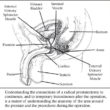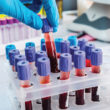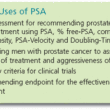What Is Normal?
(This article is an excerpt from an article featuring an interview with Dr.Catalona in Renal and Urology New, December 2008, that focuses on the problems inherent in establishing a “normal” PSA value and how these problems impact testing.)
“Normal” PSA elusive
PSA testing is a prominent example of how a “normal” clinical value is derived, accepted, and continuously revised.
When Dr. Catalona was as an attendee at a 1988 NIH conference on prostate cancer, he introduced the idea of using the PSA test for diagnostic purposes.
Because he had been collecting PSA values on all of his patients— whether they had prostate cancer, benign prostatic hyperplasia, or no such problems—he even ventured that 4 ng/mL would probably be an appropriate cutoff point for “normal.”
Dr. Catalona was all but shouted down by his fellow attendees. Although the PSA test had been heartily approved two years earlier as a marker for men with established prostate cancer.
“Nobody believed it could be used as a screening test for prostate cancer because it wasn’t perfect,” Dr. Catalona said.
He further explained that there were some men with high PSA who didn’t have prostate cancer, and there were some men with low PSA who did. Everybody wants a cancer test that is as accurate as a pregnancy test: They want something that when it’s positive, the woman is always pregnant, and when it’s negative, the woman is never pregnant.
“They want a test which tells them this is definitely 100% abnormal and that is definitely 100% normal. The idea of using the PSA test diagnostically was rejected at first because it couldn’t do that,” he said.
Eventually, he convinced a skeptical PSA test manufacturer to supply him with 1,000 kits at cost for a study. His approved protocol dictated that a value greater than 4.0 was suspicious for cancer and biopsy would be recommended….
Some experts are pushing to use PSA velocity instead of PSA thresholds.
Dr. Catalona published his results on 1,600 men in The New England Journal of Medicine in April 1991 (324: 1156-1161). The study ultimately involved 36,000 men over 12 years.
Such a large and long-term trial captured the attention of the scientific world when the results revealed that men with a PSA greater than 2.5 incurred a nearly 50% risk of having it rise above 4.0 within four years.
But because of the strict protocol, no patient could undergo biopsy until he hit the “normal” cutoff point of 4.0— even though he may well have developed cancer by then.
Dr. Catalona implored the institutional review board to allow him to change the protocol cutoff to 2.5….
“It isn’t that you were doing biopsies that you wouldn’t have otherwise done,” Dr. Catalona explained. “You were just moving them up and detecting cancer earlier.”
The likelihood of curing cancers contained within the prostate and had clear surgical margins improved from about 70% using the 4.0 cutoff to 81% using the 2.5 cutoff.
The change to 2.5 was controversial, but further work conducted by Dr. Catalona’s team, in collaboration with researchers from the Harvard School of Public Health in Boston, showed that many cancers were being missed even at that threshold.
Because it has become apparent that there is no cutoff below which a patient can be considered without cancer, some experts are pushing to abandon the use of PSA thresholds. Instead, many are turning to PSA velocity—the year-to-year rise in test values.
Steady increases are certainly a cause for concern, as shown by H. Ballentine Carter, MD, director of the Division of Adult Urology, and Alan Partin, MD, PhD, Chairman of the James Buchanan Brady Urological Institute, both at Johns Hopkins University School of Medicine in Baltimore.
“Understanding how to use PSA tests has gotten a whole lot more complicated over the years,” Dr. Partin observed. “Probably the first inkling we had that there was really no such thing as a ‘normal’ test was right around the early 1990s when someone figured out that because older men had bigger prostates due to their age, you could really expect them to have a little bit higher value.”
As a result, Dr. Partin said, older men could avoid undergoing potentially painful and anxiety-producing biopsies. “But after about three or four years, we found out that we were missing a lot of potentially life threatening cancers by not doing biopsies on those men.”
Urologists soon found that age was not the only factor skewing results.
“We began to notice that we couldn’t use the test the same way for all races. For an African American man, it was better to use a cutoff value a bit lower than for a Caucasian.”
“Nobody really understood if that was due to genetics or diet or culture. We investigated certain genes to see if perhaps the androgen receptor in some men] was more sensitive to the blood test. Nothing really came out of it,” Dr. Partin said.
“You have to start someplace”
All the refinements made in the search for hitting on the most actionable PSA values may have complicated things more than simplified them. Yet overall, Dr. Catalona and his team announced, PSA serum measurements were indeed an effective means of detecting prostate cancer; the U.S. age-adjusted prostate cancer death rate has fallen by 40%.
As for the twists and turns along the way, Dr. Catalona summed them up this way: “You can look at the numbers and perhaps see that a value of 4 was a pretty good place to draw the line; it was going to detect most of the early cancers. There will be a few false positives and some cancers will be missed, but on balance, it was a good place to start.
“You have to start someplace, but then you absolutely have to keep an open mind that it may not be the best way to go.”
Dr. Partin echoed that view. “We’re beginning to understand how to detect those cancers and follow them. Part of that is [related to] this whole understanding of what’s normal for this blood test and how it changes with time,” Dr. Partin says.
“Of all the markers available for cancer, he added, PSA as a marker for prostate cancer is the most reliable.”
PSA levels by age
In their most recent analysis of the PSA study involving 36,000 men, Dr. Catalona’s team, in collaboration with Stacy Loeb, MD, now a urology resident at Johns Hopkins, has revealed that the median PSA value is 0.7 for men in their 40s, 0.9 for men in their 50s, 1.3 for men in their 60s, and 1.7 for men in their 70s.
If a man had a PSA value below the median for his age group, his risk of being diagnosed with prostate cancer during the study was very low, Dr. Catalona noted.
If his PSA was higher than the median value for his age group, the risk was higher than in the general population.
“The higher the PSA, the greater the risk for prostate cancer and the greater the risk for aggressive disease. It is noteworthy that all of these median values are below 2.5 and substantially below 4.0,” Dr. Catalona said.
Dr. Catalona said his current approach is to be concerned about any man whose PSA is above the median value for his age group. This concept has been incorporated into the National Comprehensive Cancer Center Network (NCCN) guidelines for prostate cancer screening.
Clinical advice
His concern about a patient’s having prostate cancer becomes heightened if a PSA higher than the age-group median does not come down with antibiotic therapy or spontaneously on repeated measurements,”
“I strongly recommend a biopsy for any man whose PSA shows a steadily upward trend, especially if it increases more than 0.35 per year consistently.
“The importance of a steadily rising PSA has been quantified by Dr. Carter of Johns Hopkins and is called a ‘risk count number’—that is, the number of times the PSA has increased over time.
“And I believe a biopsy should definitely be considered in any man whose PSA is higher than 2.5, unless he has an enlarged prostate and a reasonably high percentage of free PSA,” Dr. Catalona said.











